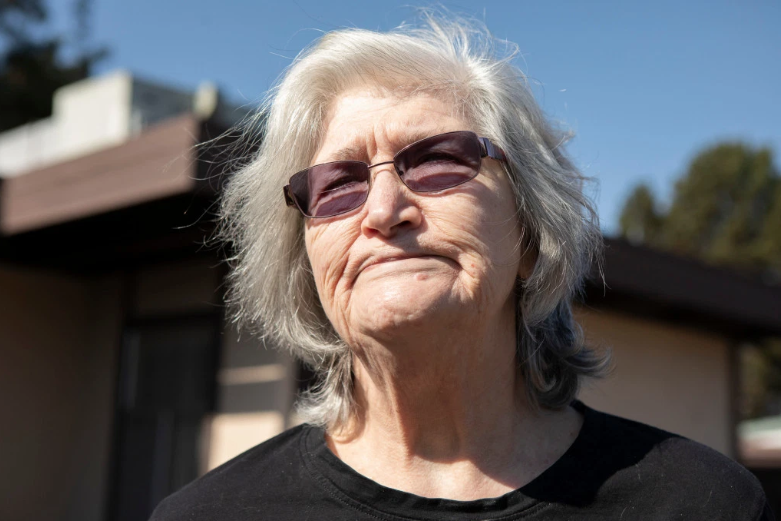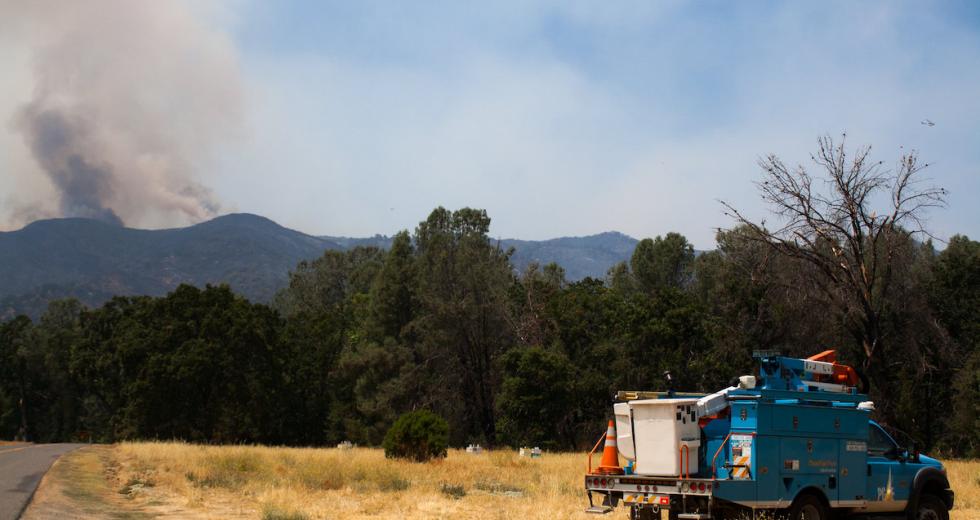Gov. Gavin Newsom’s lambasting of PG&E as California reels from wildfires and mass blackouts reflects his roots in San Francisco — and a public perception that’s built up over the last half century.
Dianna Carriger didn’t mince words as she wheeled a cart of groceries through a Bay Area mobile home park for low-income seniors.
“I’m pissed off at PG&E,” said Carriger, 78.
It had been less than 24 hours since the electricity had come back on following a three-day outage intended to minimize fire risk. Carriger finally had a cold fridge in which to stow the milk and pork chops she’d picked up from a charitable food giveaway. But inside her home, a camping lantern still sat on the kitchen table and towels lay on the floor sopping up water that leaked from the freezer while the power was cut off.
“How could that many people be in charge and do such big screw
ups?” asks PG&E customer Dianna Carriger, 78, who was left
without the machine she relies on to control her sleep apnea
during a recent public safety outage. (Photo by Anne Wernikoff
for CalMatters)

Fuming at Pacific Gas & Electric has been rampant this month as 2 million Californians have been disrupted by blackouts meant to prevent wildfires that could be sparked by the utility’s equipment. Thousands of people have been displaced by fires, at least one of which may have been caused by a power line the utility didn’t shut down. The company is already in bankruptcy from its liability for sparking the deadliest fire in state history, which killed 85 people last year and devastated the mountain town of Paradise.
Though anger at PG&E may be at record levels, it’s not a new phenomenon in northern California. Frustration with PG&E has been part of the cultural zeitgeist for decades. Gov. Gavin Newsom’s harsh rhetoric in recent weeks — criticizing PG&E for “greed and mismanagement” and “prioritizing profit over public safety” — reflects a public attitude that’s built up over the last half century.
San Francisco’s alternative newspaper began lambasting the company 50 years ago for thwarting attempts to create municipal power, a theme that continued to play out in its pages for many years. Erin Brockovich became a household name nearly 20 years ago when her lawsuit accusing the company of contaminating drinking water became the subject of a Hollywood film.
In 2010, PG&E spent $46 million pushing a ballot measure to make it harder for cities to form municipal utilities; voters rejected it as a monopolistic power grab. A few years later, PG&E was criminally convicted for its role in a gas line explosion that killed eight people and destroyed 38 homes.
“Mother Nature,” Newsom quipped Wednesday, “has… a better track record.”
His response, naturally, has involved far more than snark: He signed a law requiring more inspections of electrical equipment, and a new emphasis on safety on utilities’ corporate boards. He appointed a new chair to the commision that regulates utilities, and budgeted $1 billion for thinning trees and other projects to improve forest health. The state has deployed high-tech solutions too, with high-def cameras and radar to detect early signs of fire and communicate with crews on the ground.
But his focus on the state’s largest investor-owned utility, and all they represent, has become a theme as Newsom tours fire-ravaged communities and poses for selfies with Californians frustrated and frightened by blackouts.
“They have spent decades, not focusing on you but focusing on themselves, focusing on shareholders,” he said during a visit to Carriger’s mobile home park in the town of American Canyon. “Focusing — with respect — on Wall Street. Not public safety.”
It’s a tone Californians might expect from a governor steeped in PG&E’s long, hostile history with its sprawling service area in Northern California, where Newsom grew up and served as Mayor of San Francisco. It also belies the longstanding relationship he has had with PG&E, which, like most major employers, works with — and contributes regularly to — elected officials.
The company donated $58,400 — the maximum allowed — to Newsom’s gubernatorial campaign last year, and another $150,000 to an independent committee supporting him. PG&E executives kicked in at least $26,000 to Newsom’s 2018 election fund, and tax filings show the company’s foundation has given $120,000 to the nonprofit run by Newsom’s wife.
Newsom has sided with and against PG&E at various points in his career. He said the money isn’t a factor: “The contributions to me sure as hell haven’t influenced me to be more positive.”
“The Legislature must be more aggressive in treating PG&E
like the felon it is, rather than a business we are trying to
keep solvent,” says Assemblyman Marc Levine, meeting here with
angry utility customers in American Canyon on October 30, 2019.
(Photo by Anne Wernikoff for CalMatters)

“While there is an enormous amount of blame to be apportioned to PG&E, writing snitty letters and attacking them strikes me as not what is needed in the moment,” he said.
“This is so widespread and complicated, I think it’s almost a Katrina moment. We have a catastrophe in our midst and we’ve got to find a way to have an orderly response.”
Others took the opposite view, saying Newsom’s criticism may help empower regulators and lawmakers.
“The Legislature must be more aggressive in treating PG&E like the felon it is, rather than a business we are trying to keep solvent,” said Assemblyman Marc Levine, one of a handful of Democrats who voted against a sweeping bill this year to create a fund to cover future wildfire liabilities and require utilities invest in safety upgrades in order to access it.
“The language the governor is using will help direct stronger policy than we have seen.”
That’s going to be necessary because voters will hold politicians accountable if widespread power outages become routine, said Mark Baldassare, president of the Public Policy Institute of California.
“From what we’ve seen in the past, the public doesn’t react well to power shut downs and erratic electricity,” he said, referring to the energy crisis that culminated in the recall of Gov. Gray Davis in 2003.
“The public thinks if utilities that are regulated by state government aren’t acting appropriately, they’re going to point their finger at state government. Coming up with solutions is on the state’s leaders.”
PG&E, in a statement, said the company appreciates the “feedback” it has received about the shutoffs, but defended them as a necessary precaution.
“While we recognize that the scope of these events is unsustainable in the long term, it was the correct decision given the large-scale, historic weather event and ensuing equipment damage that unfolded across our service area,” PG&E spokesperson Tamar Sarkissian wrote in an email.
Patrick McCallum, who lost his house during the 2017 Santa Rosa fire, said things are going better this fire season. He’s received emergency alerts on his cell phone and is grateful that the Kincade Fire in Sonoma County didn’t reprise the mass tragedies of the last two years.
“Powering down is a necessary evil for a company that criminally didn’t invest into safety equipment in the last 20 years. Its criticism is deserved,” said McCallum, a lobbyist who represents fire victims.
In his view, Newsom is showing that he gets it. As for PG&E? The benefit of California’s doubt may take a while.
—
CalMatters.org is a nonprofit, nonpartisan media venture explaining California policies and politics. Comstock’s is a CalMatters media partner.
This story was originally published on CalMatters.org under the headline: “Comforting California, Newsom bashes a familiar villain — PG&E”



